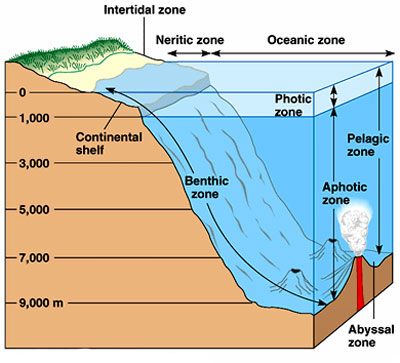|

July 22, 2010
from
PreventDisease Website
Marine biomes cover 75% of the earth's
surface and have an enormous impact on our planet's climate.
In the
benthic zone, these biomes supply
more than half of the world's oxygen. As a consequence of
the BP oil disaster, scientists are
very concerned about the global oxygen supply if this layer of the
ocean becomes saturated with contaminates of oil and other toxins.
The benthic zone or realm is subdivided on the basis of depth into
different zones which extend from high tide to the continental shelf
and deep-sea realm.
The continental shelf is a gently
sloping benthic region that extends away from the land mass. At the
continental shelf edge, usually about 200 meters deep. The deep-sea
realm includes the sediment surface and some sub-surface layers.
Organisms living in this zone generally
live in close relationship with the substrate bottom; many such
organisms are permanently attached to the bottom.

The living organisms that live down in
the benthic zone must rely on decaying animals for food or the
hydrothermal vents. The hydrothermal vents get their energy from
chemical reactions and spew hot mineral rich water into the
environment.
The consumption of phytoplankton production by the organisms in the
benthic layer is an important component of organic carbon budgets
for continental shelves. Sediment texture is a major factor
regulating benthic processes because fine sediment areas are sites
of enhanced deposition from the water column, resulting in increased
organic content, bacterial biomass and community metabolism.
Fish, whales, dolphins, crabs, seabirds, and just about everything
else that makes a living in or off of the oceans owe their existence
to phytoplankton, one-celled plants that live at the ocean surface.
Phytoplankton are at the base of
what scientists refer to as oceanic biological productivity, the
ability of a water body to support life such as plants, fish, and
wildlife.
"A measure of productivity is the
net amount of carbon dioxide taken up by phytoplankton," said
Jorge Sarmiento, a professor of atmospheric and ocean sciences
at Princeton University in New Jersey.
The one-celled plants use energy from
the sun to convert carbon dioxide and nutrients into complex organic
compounds, which form new plant material. This process, known as
photosynthesis, is how phytoplankton grow.
Robert Frouin, a research meteorologist with the Scripps
Institution of Oceanography in La Jolla, California, said
understanding the process by which phytoplankton obtains ocean
nutrients is important to understanding the link between the ocean
and global climate.
"Marine biogeochemical processes
both respond to and influence climate," Frouin said. "A change
in phytoplankton abundance and species may result from changes
in the physical processes controlling the supply of nutrients
and sunlight availability."
Oxygen Supply
At Risk
Phytoplankton need two things for photosynthesis and thus their
survival:
-
energy from the sun
-
nutrients from the water
Phytoplankton absorb both across their
cell walls.
In the process of photosynthesis, phytoplankton release oxygen into
the water. Half of the world's oxygen is produced via phytoplankton
photosynthesis. The other half is produced via photosynthesis on
land by trees, shrubs, grasses, and other plants.
As green plants die and fall to the ground or sink to the ocean
floor, a small fraction of their organic carbon is buried.
It remains there for millions of years
after taking the form of substances like oil, coal, and shale.
"The oxygen released to the
atmosphere when this buried carbon was photosynthesized hundreds
of millions of years ago is why we have so much oxygen in the
atmosphere today," Sarmiento said.
The air we breathe is approximately 21
percent oxygen and phytoplankton and terrestrial green plants
maintain a steady balance in the amount of the Earth's atmospheric
oxygen.
Marine biologist Stephen Mottram says that the current toxic
load in the Gulf which is venturing well out into Atlantic waters
will eventually threaten a large percentage of the world's
phytoplankton community.
"The balance and concentration of
phytoplankton in the upper benthic layer is critical to the a
major portion of world's oxygen and this community is now being
exposed to major threat from the BP disaster and so-called clean
up."

Mottram estimates that if there is as
little as a 20% reduction in phytoplankton populations, a
catastrophic sequence of global cooling would occur.
"Toxins in the Gulf and surrounding
waters will eventually create carbon dioxide deficiencies in the
oceans and the result will be a dramatically reduced
phytoplankton population... this will cause a cascade of
phenomenon that will eventually affect almost every organism in
the world."
Mottram added that,
"climate would inevitably change
globally as reductions in phytoplankton would directly influence
temperate climates causing them to shift to cooler
temperatures."
Mottram's primary concern is that the
increased number of dead zones in the Gulf will spread to the entire
Atlantic ocean and beyond in due time.
"It is a literal poisoning and
suffocation of the ocean and all marine life. Once nutrient
cycling slows down or comes to a halt for the primary producers,
more than 90% of marine life will die and the consequences to
all mammals (including humans) will be devastating."
|


